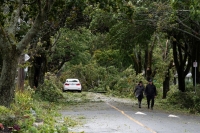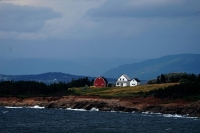Nova Scotia has long been seen as a relative climate haven in Canada, yet farmers in the Atlantic province have faced a series of debilitating hardships recently as extreme weather escalates.
Storms, floods, a cold snap and record wildfires have all battered the eastern province over the last 12 months, devastating crops, harming animals, and leaving farmers such as Matthew Roy increasingly concerned about what could come next.
"Let's bring it all on. We had the floods, we had the dry (spell), we had the fires — let's bring the locusts and see what happens," said Roy, who moved from the U.S. state of New Hampshire to Nova Scotia in 2020 and opened Coastal Grove Farm.
"Can we get it all in one year and really test us totally?" the 56-year-old said wryly, flashing two thumbs on his farm overlooking water that stretches out into the Atlantic Ocean. "Can you actually prepare for all the potential events that are going to be coming?"
For many farmers like Roy, Nova Scotia has been an appealing relocation destination due to its historically moderate climate and proximity to the Atlantic — with surrounding waters helping buffer land from weather extremes harmful to crops.
But climate change is now taking its toll on the province and rising average annual temperatures — projected to increase by 2.6 degrees Celsius by 2050 and 4.5 C by 2080 — could hike the risk of wildfires and droughts, the local government says.
First, the remnants of Hurricane Fiona — one of the worst storms to hit Canada — pummeled farms last year, destroying crops and equipment.
Among other aid efforts, Nova Scotia's agriculture department provided more than 15 million Canadian dollars ($11.1 million) via a special disaster program that helped more than 500 producers.
Then, farmers had to deal with extreme temperature variations as December and January were among the warmest on record before a cold snap hit in February — ruining crops such as grapes that had not been acclimatized for the sudden shift.
And a wildfire that started in May — Nova Scotia's largest blaze in recorded history — forced farmers to evacuate their property, relocate livestock, and pick up the pieces upon their return, only to be hit by a massive deluge of rain last month.
"We've gotten used to having this moderate climate for generations, and we are seeing now a little bit more of these climate extremes," said Steve Ells, president of the Grape Growers Association of Nova Scotia.
Due in part to the temperature fluctuation between December and February, grape growers will not have a crop this year of vines such as chardonnay and pinot noir that comprise more than one-third of those planted in Nova Scotia, Ells explained.
"It's going to take us a couple years to get back to full production," he added.
In the short-term, farms in Nova Scotia are trying to become more resilient by investing in measures such as covers and tunnels that shield crops from extreme weather.
Looking further ahead, the province, through a national partnership, aims to promote climate-smart practices, from recycling wastewater streams to installing weather stations.
"Really as an agricultural industry, we're thinking ahead and trying to be innovative to mitigate and reduce our risk for all the way(s) the climate is changing," said Janice Lutz, vice president of Farm Safety Nova Scotia, a not-for-profit group.
When Roy moved to Nova Scotia in 2020, he was enthused about growing crops like saffron and tea — rarities for the region but ones that seemed feasible due to the province's climate.
"We were gambling on the shoreline of this location as being, in 10 years, more hospitable for crops that technically haven't been able to have been grown here," Roy said.
Yet the cold spell contributed to a reduction in pollinators like bees at his farm, Roy said, before the fire forced him to evacuate for more than a week and meant that some of his planting schedule and income were set back by two months or so.
Similar to Roy, farmers Sarah Kistner and her husband Carl also moved to Nova Scotia a few years ago for climate reasons.
The couple had been frustrated by wildfires in the western province of British Columbia disrupting their farm there, and hoped for better conditions on the other side of the country.
Yet Kistner — who with her husband runs Stone Meadow Gardens, a flower farm in western Nova Scotia — said this year's combination of humidity and rain in the region has been a challenge compared to last summer.
"We had the fire, and we were in a drought, and now it has not stopped raining. And so we're losing crops to fungal and bacterial diseases — they are literally drowning," she added.
Canada as a whole has already broken a wildfire record with more than 32 million acres burned so far this year, and the resulting smoke has affected air quality levels as far away as the southeastern United States and even parts of Europe.
Some farmers in Nova Scotia have started taking steps to become more resilient to climate extremes — albeit limited ones.
For example, Roy's greenhouse has a curved roof as a partial buffer against the wind. He also puts more organic matter into the soil to absorb moisture and has raised beds for his saffron so the crop has better drainage in the summer when it's dormant.
"Be it heavy rains, wind events, droughts, wildfires — there's starting to be awareness in the province that we need to do some preparedness work to get farms so that they're more resilient," said Roy, who is also a board member of the Nova Scotia Federation of Agriculture, an advocacy group.
Yet Kistner said that installing measures such as tunnels — which protect crops from extreme weather — was expensive.
More broadly, farmers can take other steps like planting trees between rows of crops, which can cut down on lost topsoil during floods and help sequester carbon, said Haley Leslie-Bole of the World Resources Institute (WRI), a think tank.
She also acknowledged that such steps can be costly — but said farmers in general might need to adapt to succeed in what was now a global industry with far-reaching supply chains.
"Even if one place continues to be more favorable for agriculture than others, that place isn't divorced from the global commodity market," said Leslie-Bole, an expert focusing on climate issues for WRI.
On Coastal Grove Farm, as Roy walked from a greenhouse back down toward the water, he lamented the tight margins smaller farms face as they try to keep up.
"My competitor is in Peru, is in Mexico, is in China," he said. "So we can't even build into our pricing system capacity to build resiliency because we don't control it."






















With your current subscription plan you can comment on stories. However, before writing your first comment, please create a display name in the Profile section of your subscriber account page.